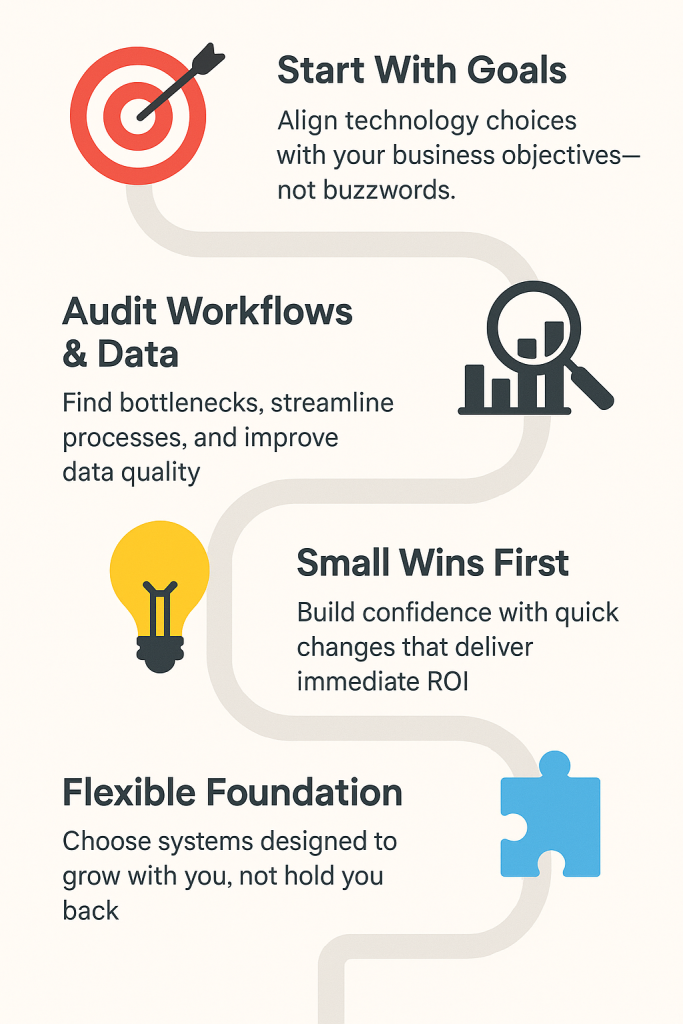For many small and mid-sized organizations, technology can feel like a moving target. Every week brings a new buzzword (AI, automation, digital transformation) while your core systems feel increasingly outdated. Your data may be scattered across tools, workflows may depend on manual processes, and the thought of a major modernization project can feel overwhelming.
You’re not alone. Across industries, small and mid-sized organizations often struggle to keep up with the speed of technological change while balancing day-to-day operations. Yet modernization doesn’t have to be disruptive or intimidating. It is a strategic, step-by-step process that aligns your technology investments with your business goals and, when done right, it can be transformative.
This post will help you reframe modernization as a series of practical, achievable steps that move you from feeling overwhelmed to being ahead of the curve.
Why Modernization Feels Overwhelming
Small businesses frequently cite barriers like cost, lack of expertise, and integration complexity as reasons for delaying tech adoption. A 2023 study from AI Business found that many organizations hesitate to invest in modern solutions because of a lack of in-house expertise and concerns over security and ROI (AI Business, 2023). Similarly, a 2025 TechRadar report noted that small and mid-sized businesses (SMBs) often see technology investment as a financial risk, even while recognizing its necessity for growth (TechRadar, 2025).
40% of business leaders cite lack of expertise as a barrier to technology adoption.
(AI Business, 2023)
Yet, delaying modernization comes with its own costs: slower operations, missed opportunities, and competitive disadvantage. Encouragingly, businesses that have embraced digital tools overwhelmingly report efficiency gains and optimism about future growth (U.S. Chamber of Commerce, 2023).
The good news is that modernization doesn’t need to be a massive leap. A structured, goal-driven approach can help you take small, confident steps forward.
A Practical Approach to Modernization
Modernization should be driven by your strategic business goals, not by chasing the latest technology trend. Here’s an approach to help you get started.
1. Start with Your Goals, Not the Tech
Before looking at software, hardware, or AI models, ask yourself: “What business problems do I need to solve?” Are you trying to speed up workflows, improve decision-making, enhance customer experience, support growth, or a combination of these and other goals?
When organizations align IT initiatives with clear business objectives, they see higher ROI and faster decision-making (Davenport, 2024). Modernization is most effective when it’s a means to an end, not an end in itself.
2. Audit Your Workflows and Data
A modernization journey should start with a clear picture of your current state:
- Workflows: Identify bottlenecks, redundant tasks, or manual processes that slow your team down.
- Data: Evaluate the quality and organization of your data. What’s reliable? What needs cleaning? Are there gaps preventing meaningful analysis?
This audit creates a roadmap for targeted improvements. Often, even simple steps—like consolidating duplicate data sources or automating a repetitive report—can deliver measurable time savings.
The term “audit” can be overwhelming in itself, as we often picture a laborious, top-down, expensive deconstruction of every process. While that can be useful, it’s not always necessary. Often, you or your staff are already intimately familiar with the inefficiencies in your operations and these can be captured via interviews. This is often enough to get started.

3. Prioritize Small, High-Impact Wins
Modernization doesn’t have to mean overhauling everything at once. Start small:
- Automate a single, repetitive process.
- Consolidate reporting into a single dashboard.
- Migrate one high-value workflow to a cloud-based solution.
These small wins build momentum, reduce team anxiety, and demonstrate clear ROI, paving the way for larger initiatives.
That second benefit, reducing team anxiety, is important. While we can all recognize inefficiencies, the inefficiency you know often causes less anxiety than the improvement you don’t. Getting your team comfortable with some small, early wins builds confidence in the overall process to come.
4. Build a Scalable Technology Strategy
Once you’ve addressed the most obvious inefficiencies, it’s time to lay a scalable foundation for growth. In this context, “scalability” simply means your technology can handle increased demand, complexity, or new functionality without needing a total replacement.
Scalability means your systems should grow as you grow—without costly rebuilds.
For small and medium-sized organizations, this often doesn’t mean buying the most expensive enterprise software. It can mean:
- Choosing cloud platforms and analytics tools that allow you to add users, storage, or features incrementally.
- Using modular systems that make it easy to plug in new capabilities—like automation or AI—when you’re ready.
- Designing workflows so that new services, staff, or customers can be added without reworking everything from scratch.
By focusing on flexibility instead of “big tech,” you create systems that evolve alongside your organization’s needs. This approach can save money in the long run and reduces the stress of future growth.
Make AI and Automation Accessible
Artificial intelligence (AI) and automation are often seen as intimidating, but they don’t have to be. The key is to view AI as a tool to augment decision-making and streamline workflows rather than as a complex, abstract concept.
Practical applications include:
- Automating repetitive reporting or data entry tasks.
- Using predictive analytics to forecast demand or identify trends.
- Applying natural language processing (NLP) to analyze customer feedback.
By starting with small, low-risk pilot projects, you can test AI solutions, measure results, and gain confidence in scaling them further. These pilots often produce immediate efficiency gains, helping you build internal support for deeper adoption.
Targeted Expertise
Many growing organizations delay modernization because they don’t have a CIO, CTO, or internal team member to lead the effort. This is where fractional executive leadership or embedded technical advisors can make a difference.
A skilled advisor provides:
- Strategic vision: Ensuring your technology roadmap supports your goals.
- Vendor neutrality: Recommending the right tools for your needs, not pushing a specific platform.
- Execution support: Overseeing implementation to reduce risk and avoid costly missteps.
- Knowledge transfer: Building your internal team’s capability over time.
At Cercana, we pair executive-grade advisory services with hands-on delivery, helping organizations modernize confidently without the overhead of a full-time executive hire. Our goal is to guide you through modernization while helping you build your internal capacity so that you can move into the future on your own.
Moving Forward with Confidence
Modernization isn’t a single project; it’s an ongoing journey that starts with understanding your goals, streamlining workflows, and building a flexible foundation. By breaking the process into manageable steps and leveraging expert guidance, you can move from feeling overwhelmed to gaining a competitive edge.
The organizations that thrive in today’s landscape are those that see technology as a growth enabler rather than a burden. With the right plan and guidance, modernization can unlock new opportunities, create efficiencies, and position your business for long-term success.
Ready to start your journey? Let’s talk. We’ll help you identify your highest-impact opportunities, design a strategy that works for your business, and deliver clarity at every step.
References
AI Business. (2023, June 21). Small-medium businesses face barriers to technology adoption. AI Business. https://aibusiness.com/verticals/small-medium-businesses-face-barriers-to-technology-adoption
Davenport, L. (2024, October 27). Business and IT alignment: Why is it so important? Davenport Group. https://davenportgroup.com/insights/business-and-it-alignment-why-is-it-so-important/
TechRadar. (2025, April 1). SMBs want to use tech more in order to grow—but costs are proving a big barrier. TechRadar Pro. https://www.techradar.com/pro/smbs-want-to-use-tech-more-in-order-to-grow-but-costs-are-proving-a-big-barrier
U.S. Chamber of Commerce. (2023, September 14). The impact of technology on U.S. small businesses. U.S. Chamber of Commerce. https://www.uschamber.com/small-business/smallbusinesstech
Header Image: Bernd Fiedler, CC BY-SA 4.0 https://creativecommons.org/licenses/by-sa/4.0, via Wikimedia Commons

